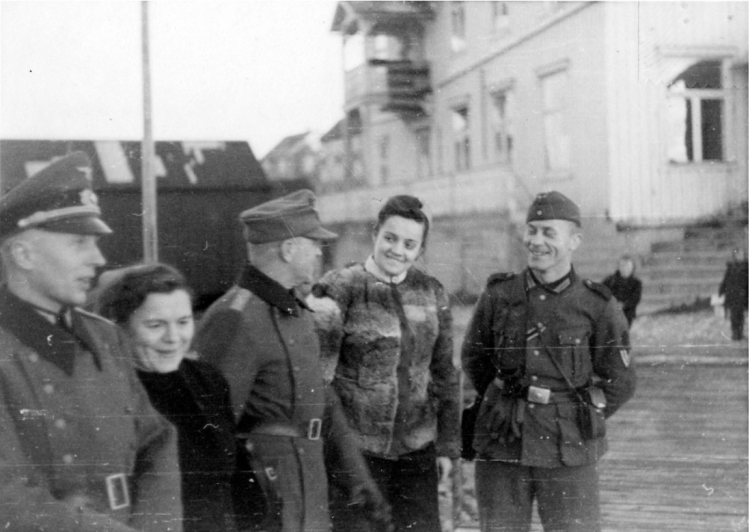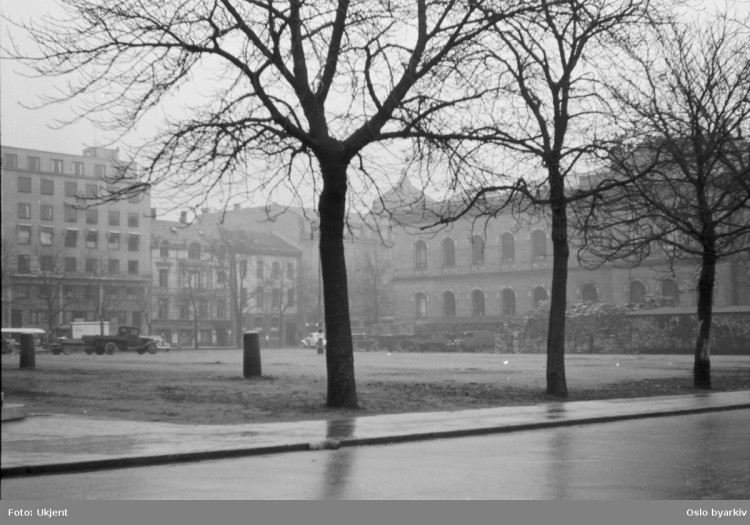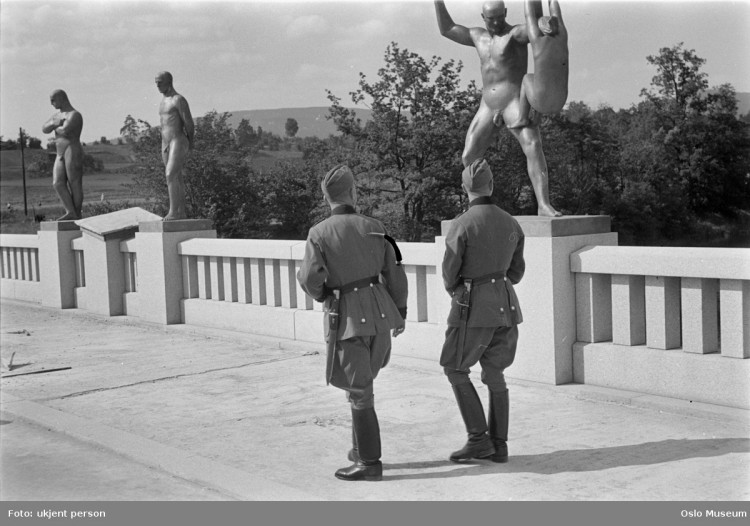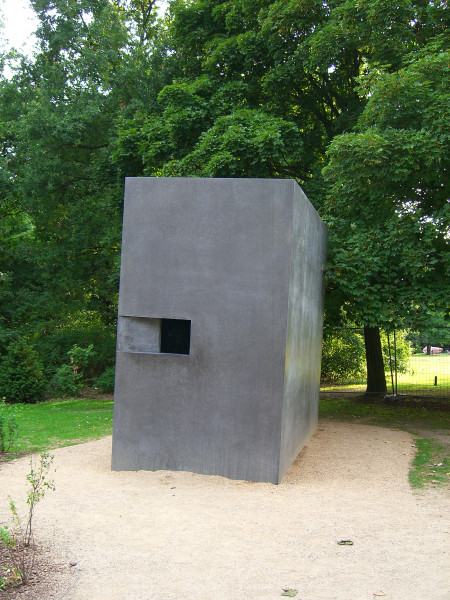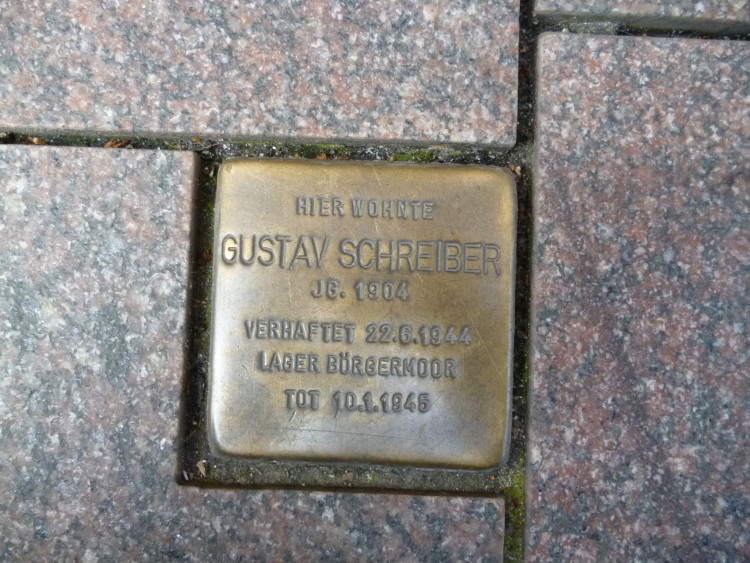- The germans were the best lovers.

One day in August 1943, Gustav Schreiber (38) arrives in occupied Norway and Bergen. The German is emplyed in a company subject to the Organization Todt. In the town of western Norway, he meets Charles Petterson (27). The two of them become in short order close friends and lovers.
The end of the relationship will be brutal, and one of them will pay with his life in a German consentration camp due to "repeated fornication with men".
Somewere between 200,000 and 500,000 German soldiers were stationed in the country during the occupation of Norway 1940 to 1945. The number changed during the different phases of the war.
From the spring of 1945, many thousands of women were arrested for their relations with Germans. Many were detained for several months without any legal basis. In August 1945, the authorities also amended the Citizenship Act to be able to deport women married to German men.
In violation of the Constitution, this arrangement was given retroactive effect. In addition, many women were exposed to the people's court. They had their hair cut for public ridicule and contempt.
For Norwegian men who had the same type of relationship with Germans, there were few or no reactions.
Many places to meet
"The Germans were the best lovers" is a quote from an informant Gunnar (67) in a conversation with Rolf Løvaas (veteran activist) in an interview from 1989.
He often had visits by German men to his small, rented room. He told openly about his relationship with an officer Walter during the war.
"He was great looking and had a nice and considerate way of being. We were together for a long time. Some of my Norwegian gay friends were probably a little jealous of me having found such a great guy. We did it like this: I went outside with a coat that Walter put over his uniform, and he put his hat in his pocket. Like this he looked completely neutral as he entered the house."
Gunnar also says in the interview where in Oslo the Norwegian and German men met. It was at the urinals at Tullinløkka park, at Klingenberg cinema, at Stortorget marketplace and under the Deichman library.
They had to be very careful and discreet.
"The Germans were also careful. I had a rule to never invite a German back to my room the first time. I made an appointment, and if he met punctually and seemed okay, I took him home."
All over Norway
Per Kristian Roghell was a central person in the organized gay life in Tromsø (city in nortern Norway) in the 1970s and '80s. He arranged informal meetings over a cup of coffee on Saturdays where the older gay men in town came by.
"They told stories from the war and German naval ships visiting. It was fabulous with so many great men in town! The meetingpoints were at a few places along the quay. They talked openly about lots of sex with German soldiers. Unlike the women, they were not mistreated after the war. Homosexuality was never talked about, so they had these good and great experiences witout anyone really noticing", he says in an interview with the Norwegian Queer Archive in 2018.
"They were nice people when they took off their uniform. Then they cursed Hitler up and down", according to Alf, another older Norwegian gay man from a town in northern Norway who was interviewed by Fritt Fram (gay magazine) in 1990. "They were willing", he says.
In 1988, over forty years after the war, the Norwegian women married to German soliders could regain their Norwegian citizenship, but only by moving back to Norway.
NRK (a major Norwegian TV station) went to West Germany to interview a whole series of these women, the so-called "war brides" (krigsbruder).
Elsa Sender, from a place in northern Norway, is one of the women interviewed. She is asked wether she fells like beeing punished for what she did during the war: "Then they should punish the whole of Norway, so to speak. For it was not only the women who went with the Germans. It was also the men, who both worked and .. well you can say… both this and that. Why should we be the only ones, the ones who married, be punished. We have stayed with only one man all our lives."
It is clear that she also knows of stories from her hometown about Norwegian men and German soldiers without her elaborating further.
Homosexuality not an issue
Dermot Mack (1914-2001) was an activist in the 50s. In an interview done by Turid Eikvam in 1984, he confirms it was not unusual for Norwegian men and German soldiers to have sexual contact. The soundrecording of this rare interview is today preserved in the Norwegian Queer Archive.
He talks about what it was like to live in Oslo during the wartime blackout, and how he noticed that more men than usual ventured out to the meeting places in the total darkness around the urinals and parks.
"There were not so few Germans there as well ... The homosexuals had a peculiar attitude. The women were called "tyskertøs" (german slut), but the men (laughs a little) were not called anything."
Dermot Mack says he did not experience any attitude against meeting Germans who showed up at the meetingplaces. But that it maybe should have been.
But Mack also refers in his interview to a German soldier who is said to have been arrested by his own side during a visit to the urinal at Ravnkloa in Trondheim in 1942. This soldier was allegedly also revealed as a British spy, and later died in a concentration camp.
Gunnar from Oslo also did not see any problem with the dealings with the Germans. At the same time he helped a friend in the resitance storing illegal newspapers, and considered himself a patriot.
"I do not look back at the wartime as a gloomy period. I blossomed as a young gay man, some would say I was a rag, yes, but I would say that I was greedy for life."
So how can it be that many look back to the occupation period as a time for a flourishing underground gay scene when at the same time Nazism otherwise stood for a policy of persecution against homosexuals?
Part of the activity may have gone under the radar because brotherhood and camaraderie were central to both Norwegian and German propaganda.
Homosexuality was also not a topic that was talked about to a significant degree. Erotic love affairs disguised as friendship may thus have been easier to hide than it would have been today.
In Germany itself, on the other hand, 50,000 men were convicted of homosexual acts under the Nazi regime. Between 5 and 15,000 of these ended up in concentration camps. It was also in these camps they were marked with the pink triangle.
Heinrich Himmler in particular, the "Reichsführer SS", was at the forefront of the persecution of homosexuals. In order to coordinate the efforts, the Reichszentrale zur Bekämpfung der Homosexualität und Abtreibung (National Center for Combating Homosexuality and Abortion) was established.
Norwegian legislation
Section 213 of the Norwegian Penal Code of 1902 criminalized "immoral intercourse between persons of the male sex" with imprisonment for up to one year. But the third paragraph of the section said that prosecution should only take place out of "public interest".
The paragraph was usually only in use for cases where one party was under 21 years of age. Between 1905 and 1950, 119 men were convicted.
Both the German occupation authorities and the Norwegian nazi-regime under Minister of Police Jonas Lie wanted to tighten the ban, but for various reasons this did not work out. On the other hand, German law was used in some cases.
Runar Jordåen at the Norwegian Queer Archive and Raimund Wolfert at Magnus Hirschfeld Gesellschaft in Berlin, have done more research. They have arrived at a number of 15 Norwegians and three Germans who were indicted and had to appear before a German court in Norway.
Died in a concentration camp
Let us go back to Gustav and Charles in Bergen. As early as 1937, Gustav was convicted for the first time in his home country for having sex with men. He was then sentenced to one year in prison. After this sentence was served, he got the job in a construction company that led him to occupied Norway.
Gustav quickly met Charles after moving to Bergen, and the German got his friend both a job in his office and let him live in his apartment.
As early as March 15, 1944, the two were arrested after being turned in by a neighbor. Whether it was the fact that they were two men, or an expression of German hatred that betrayed the two, we know nothing about.
The Germans acted quickly. Only eight days later Gustav was sentenced to two years and three months in prison. The verdict was decided by the «Feldkriegsgericht Bergen der 269th Infantry Division.
The sentencing was seen in light of the fact that he was a "Hangtäter" (habitual criminal), because he had been convicted of similar offenses in the past. Charles was also charged and convicted under German § 175, but his sentence was considerably milder, one year and three months behind bars.
Gustav was sent back to Germany to serve his sentence, and ended his life in the Börgermoor concentration camp on January 10, 1945, only 40 years old.
Charles survived the war and did not die until 1980. He is buried in Møllendal cemetery in Bergen.
In 2007, Gustav Schreiber had a so-called stumbling stone (Stolperstein) laid down in Flensburg, as a victim of the Nazis.
17 October 2018, Norwegian Prime Minister Erna Solberg gave an unreserved apology to the "German girls" (tyskerjentene) for the treatment given by Norway after the war.

